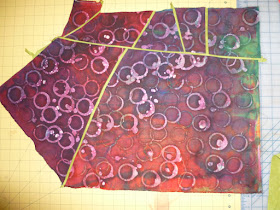Rosalita was one of the founders of "And Then We Set It On Fire." In fact, it was Rosalita and Beth who coined the phrase after accidently setting a piece on fire during their early surface design experiments. She has agreed to be our guest artist for July. Thank you, Rosalita.
Judith
***
Hello All,
Sorry this post is so close to the end of the month of June. I have been busy getting ready for eight shows that I have starting with the first weekend in July.
This technique is one utilizing interfacing, glue, lace, yarns, strings, paint., gesso, etc.
Things you will need.
Fabric (I used muslin, but you can use any fabric like interlining)
PVA glue (you can use Elmer’s Glue)
Tissue paper (I used white)
Scrim
Lace
Acrylic paint
Materials for texture - yarn, beads, etc.
Preparing the Surface
The first step is to prepare the fabric. Using a mixture of 3 ½ pints of water and 2 cups of PVA glue mix solution in a bucket.
Put the amount of fabric you want to work with in the bucket. I would recommend a half yard to start. Completely immerse your fabric in the glue and water. Squeeze out all liquid. Keep doing this process until your fabric is completely saturated.
Hang out your fabric to dry overnight. Do not smooth out your fabric. The wrinkles will give it more texture.
Once the fabric is dried, it can be rolled up for storage.
When you are ready to do the next step of the project, iron out a piece of fabric the size you want to work with. It will not be totally flat but will leave a nice texture.
You can either cut to size now or leave it a little larger so you can select the placement at a later time.
Layering Surface Texture
Make a thin solution of PVA and water – about one tablespoon of glue to ½ cup of water.
Tear tissue paper into rough strips.
Wet your fabric with the thin glue solution. Lay the tissue paper on the fabric in different directions. Cover with thin glue solution. Continue doing this until the entire fabric has been covered.
Wet your fabric with the glue mixture again. Now you can lay some scrim (cheesecloth) on top of the glue. Cutting the scrim in rough strips. Cut the top of the scrim in two or three slits. Cover scrim with thin glue mixture. While the scrim is still wet you can take the scrim strips and twist to create movement.
You can repeat this process with lace or other items to add more design and texture. Just remember glue, material, more glue.
When you are satisfied with the look of your piece, let it completely dry.
Stitching Top
Once your piece is completely dry, now you can add any type of stitching you would like. You need enough stitching to hold down the layers you have placed on the original fabric. I used some yarn which I couched down using my sewing machine using nylon thread.
(Because this is was one of the last steps I wanted to do, I also couched some yarn with silk ribbon tabs.) (See picture)
Applying Gesso
To seal your entire piece for painting, you will apply a coat of gesso.
Put your fabric on a scrap of paper. (DO NOT USE ANYTHING WITH PRINT LIKE A NEWSPAPER)
Using a household paintbrush apply gesso in and around the treads to seal them.
Continue until the whole surface is done.
Allow piece to dry overnight.
Painting Surface
Put your piece on scraps of paper.
Using acrylic paint, squeeze out three colors that work well together. Use a large paintbrush to rewet the surface of your piece with a little water. Pick up a little paint and start in the lower right hand corner. Continue painting until you are pleased with the composition.
The following picture shows a piece done with cadmium red, cadmium yellow and Prussian blue.
My Piece
I stopped this piece at the last application of PVA glue and because I wanted the color of the muslin to show through. I added an embroidered dragonfly (my sewing machine embroiders). I wanted to try making a bead crib around a cabochon so added the sun. I also put small rows of beads at the ends of some of the grass like string I put on. The piece was the bound with cotton cloth and mounted on a stretched canvas painted on the sides to match binding. I then put hanging wire on the back.
This was a fun technique and the sky is the limit. Have fun, allow yourself to play.
Complete instructions with more pictures and other techniques can be found in "Stitch, Cloth, Paper and Paint" - Mixed Media Ideas & Inspiration, Angie Hughes, Search Press.









































 I
I











